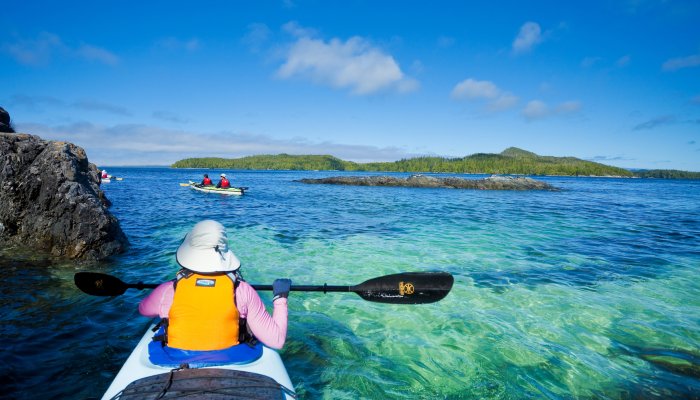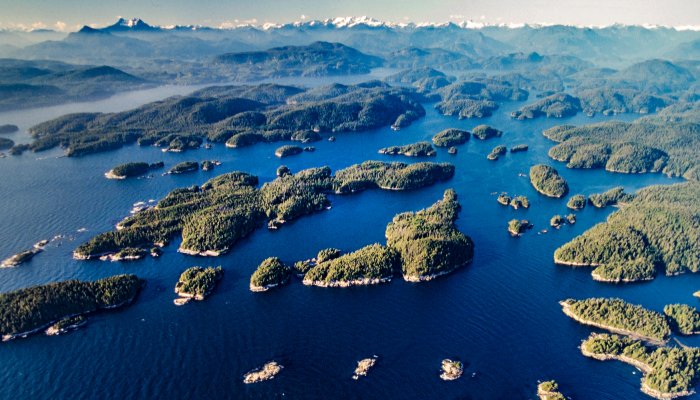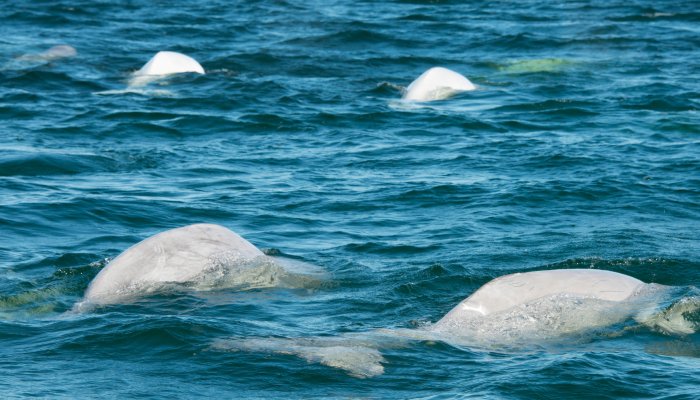Seeing a large black dorsal fin bobbing out of the water about ten feet from the shoreline is a little surprising, not to mention the five-ton body that it's attached to, swaying back and forth, propelled by a splashing tail, as it moves around on the smooth pebbles along the steep drop-off from shore. Beach-rubbing, an activity specific to one of British Columbia's four distinct populations of Killer Whales, the endangered Northern Residents, is an incredible activity to observe in person. And while beach-rubbing is not likely something most people get to see in person (check out a great video of it here), it's well worth seeking out!
Beach-rubbing is often observed in the Robson Bight (Michael Biggs) Ecological Reserve, a sanctuary for Killer Whales in British Columbia's Johnstone Strait, and the areas surrounding the reserve. While boaters are expected to refrain from entering the reserve, and the upland portion of the reserve is closed to all uses or entry, there are other rubbing beaches located outside of the reserve. Lucky for us, our Little Kai Whale Camp, located just about 3 nautical miles north of the reserve, is another orca rubbing beach!
Robson Bight (Michael Biggs) Ecological Reserve was established in 1982 to help protect the endagered Northern Residents that frequent the area. Shortly after, in 1987, the Robson Bight (Michael Biggs) Warden Program began, with the goals of protecting and monitoring whales and other marine life in the area, and educating boaters, kayakers, and visitors alike about the reserve and their impact around it. While the warden program has been managed by different entities over the years, the Cetus Research and Conservation Society has operated the program since the organization's start in 2005.
The late Dr. Michael Bigg played an instrumental role in our present day understanding of Killer Whales, hence why you might hear his name often associated with these orcas. Because of Dr. Bigg's research on orcas starting in 1973, the Killer Whales of British Columbia are the most and longest studied marine mammals in the world. Dr. Bigg developed the modern day process of identifying the whales using photo ID. Photos of the unique markings and nicks on the saddle patches and dorsal fins of the whales help distinguish the whales from one another.
In British Columbia, there are four populations of Killer Whales - the Northern Residents, Southern Residents, Offshore, and Bigg's/Transients. All of the populations have their own language, and do not mate between groups, thereby preserving their own cultures and traditions. The "Residents" are inshore, fish-eating populations; most of their diet it salmon, and, as "The Marine Detective" Jackie Hildering describes them, the "'Resident' killer whales... can best be described as 'Chinook-aholics!'"
The Southern Residents, most often found in the waters around southern British Columbia and Washington, and sometimes even in the waters of northern British Columbia, Oregon, and California, only have about 80 individuals, and the population is recognized as being endangered. The Northern Residents are also threatened, with about 170 whales in the population, and are found mostly in northern British Columbia, but also in southeastern Alaska and Washington state.
The population that most often frequents Johnstone Strait and Robson Bight are the Northern Residents. More recent studies done in the area revealed 13 pods containing about 170 whales that reside permanently between Campbell River and Prince Rupert. Robson Bight (Michael Bigg) Ecological Reserve and the adjacent waters of the reserve are key areas for the Northern Residents, and are visited mainly from June to October when salmon are migrating through Johnstone Strait.
Pods are family groups composed of subpods, which consist of an adult female and her offspring, or "matrlines," which loosely translates to "follow your mother." Resident orcas stay with their mothers for their entire lives. When the mother is gone, the remaining family members stay together. The Northern Resident families are named for the eldest female in the family, who is believed to be the leader of that group. While different pods have mostly separate vocalizations and dialects, pods that share calls are called clans. Different clans do not share calls. The Northern Residents are comprised of A, G, and R clans.
Johnstone Strait is a deep, narrow, steep-sided, glacially-carved channel separating the northeastern coast of Vancouver Island from mainland British Columbia. The strait, along with two other passages, form a key entrance in the migration route of Pacific Salmon species to major river systems on the BC mainland, which is why we see fish-eating killer whale populations in the area!
In Robson Bight (Michael Bigg) Ecological Reserve, water depths plunge rapidly to 400 m or more. The Tsitika River Estuary, the only undisturbed estuary on the east coast of Vancouver Island, is very important to the migrating salmon populations. Not only does the estuary lead to the salmon's spawning grounds, but it is also home to an abundance of two invertabrates fed upon exclusively by young salmon, making it a key rearing area. In addition, the bight's (by the way, a bight is a curve or recess in a coastline, river, or other geographical feature that forms an open bay) rocky underwater terrain is less exposed to the strong currents of the strait, allowing seaweed to grow more easily, thus providing another important feeding area for young salmon. Again, a big reason why orcas like to hang out there!
Whales in the bight behave differently than in the surrounding waters, making the reserve a very special place! Usually, there is less traveling and feeding, and more resting, play, and beach-rubbing. While we still aren't exactly sure why whales rub along the pebbles of the beaches, many scientists believe beach-rubbing must be a social and recreational behavior. And while rubbing behaviour only accounts for a very small percentage of observed whale behaviors, it is not considered abnormal - it is a regular activity for them!
While whales may be seen more regularly in Robson Bight than in other places in the strait, they are also more sensitive to disturbances. Most important of all when visiting this area (and any area with whales!) is being "whale-wise" and respecting their habitat.
While we can't enter the reserve on our trips, our guides will sometimes lead our groups by kayak along the outside of the reserve barrier. Should the whales feel like popping up to say hello, we will be graced with their incredible presence! But fear not; there are plenty of other places outside of the reserve to view the whales, and with our 95% "Orca Guarantee" the odds are in your favor! Guests on our 4-Day Orca Basecamp and 6-Day Blackfish Waters Orca Kayak tours have not only seen whales, but have also witnessed them rubbing on the beaches outside of the reserve, and even along the beach at our whale basecamp!
Fun facts About Orcas:
o Orcas are the largest of the dolphin family, ranging from 2.5 m at birth to 8 m for females and 9 m for males o Females first calve at age 11-14, and every 3-4 years until about age 40. Males are not selected for reproduction until at least age 20. Calving generally occurs from October to March after a 16-17 month gestation period. o On average, males live to age 30 and females to age 50. o Resident males remain with their birth group for life o Echolocation (sonar) is used to detect prey and navigate; they can communicate with each other up to 10 km o A typical dive sequence consists of one long dive lasting 3-4 minutes followed by three or more short dives of 15-20 seconds. They rest abreast synchronizing their breathing, and are susceptible to disturbance at this time. o Killer Whales have no natural enemies
Sources for this blog:
- http://www.env.gov.bc.ca/bcparks/eco_reserve/robsonb_er.html
- http://cetussociety.org/marine-stewardship-programs/robson-bight-warden-program/
- http://themarinedetective.com/2015/02/08/rub-me-right-beach-rubbing-behaviour-of-northern-resident-orca/
- http://themarinedetective.com/2013/04/03/whats-the-biggs-deal/
- http://www.env.gov.bc.ca/bcparks/explore/gen_info/whale_rules_poster.pdf



